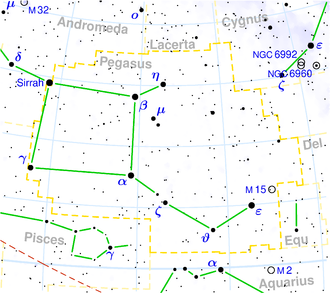IC 5231
| Galaxie IC 5231 | |
|---|---|
 | |
| SDSS-Aufnahme | |
| AladinLite | |
| Sternbild | Pegasus |
| Position Äquinoktium: J2000.0, Epoche: J2000.0 | |
| Rektaszension | 22h 34m 00,7s[1] |
| Deklination | +23° 20′ 19″[1] |
| Erscheinungsbild | |
| Morphologischer Typ | S0-a?[1] |
| Helligkeit (visuell) | 14,5 mag[2] |
| Helligkeit (B-Band) | 15,5 mag[2] |
| Winkelausdehnung | 1.00 × 0.9[2] |
| Positionswinkel | 69°[2] |
| Flächenhelligkeit | 14,2 mag/arcmin²[2] |
| Physikalische Daten | |
| Rotverschiebung | 0.024927 ± 0.000467[1] |
| Radialgeschwindigkeit | (7473 ± 140) km/s[1] |
| Hubbledistanz vrad / H0 | (343 ± 25) · 106 Lj (105,1 ± 7,6) Mpc [1] |
| Geschichte | |
| Entdeckung | Stéphane Javelle |
| Entdeckungsdatum | 9. Oktober 1895 |
| Katalogbezeichnungen | |
| IC 5231 • PGC 69166 • CGCG 474-007 • MCG +04-53-004 • 2MASX J22340076+2320190 • Mrk 913a • GALEXASC J223400.78+232018.5 | |
IC 5231 ist eine linsenförmige Galaxie vom Hubble-Typ S0-a im Sternbild Pegasus am Nordsternhimmel. Sie ist schätzungsweise 343 Millionen Lichtjahre von der Milchstraße entfernt und hat einen Durchmesser von etwa 100.000 Lj.
Im selben Himmelsareal befindet sich u. a. die Galaxie NGC 7332.
Das Objekt wurde am 9. Oktober 1895 von Stéphane Javelle entdeckt.[3]
Weblinks
Einzelnachweise
Auf dieser Seite verwendete Medien
Autor/Urheber: Sloan Digital Sky Survey, Lizenz: CC BY 4.0
The sky image is obtained by Sloan Digital Sky Survey, DR14 with SciServer.
Angle of view: 4' × 4' (0.3" per pixel), north is up.
Details on the image processing pipeline: https://www.sdss.org/dr14/imaging/jpg-images-on-skyserver/



